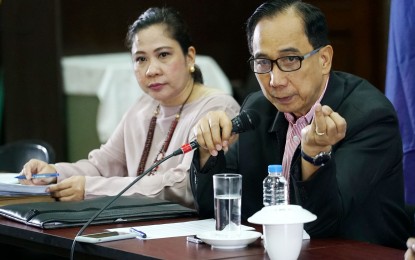
Agriculture Undersecretary for Agri-Industrialization and for Fisheries Cheryl Natividad-Caballero (left), and Agriculture Secretary William Dar. (PNA file photo)
MANILA – The Department of Agriculture (DA) on Monday said efforts of the government to produce more fish through its "intensive hatcheries" will contribute to the Philippines’ food security.
“(Our technologies in fish production) are stable and we are already 100 percent food sufficient,” DA Undersecretary for Agri-Industrialization and Fisheries Cheryl Natividad-Caballero told Philippine News Agency.
She said the agency is now moving forward to have higher value addition of fish produce while ensuring the availability of fry for aquaculture farmers.
Tilapia Intensive Hatchery
The Bureau of Fisheries and Aquatic Resources (BFAR), in a statement, said the agency recorded a high hatching rate of 95 percent in its second tilapia intensive hatchery in Los Baños, Laguna.
“With 95 percent hatching rate and 80 percent survival of fry, the hatchery can produce around 960,000 fry in a month,” said BFAR national director Eduardo Gongona, adding that after the successful trial, the hatchery aims to complete four rounds of hatching per month.
Currently, the hatchery, which has six fry troughs and hatching jars, can produce 300,000 fry in three to five days.
BFAR added that the tilapia intensive hatchery project is part of their Tilapia Commodity Program to secure a sustainable supply of fry/fingerlings.
“(This successful move is another step towards the agency’s goal of helping tilapia farmers achieve ‘masaganang ani at mataas na kita' (bountiful harvest and high income) as envisioned by Agriculture Secretary William Dar,” Gongona said.
Aside from producing high volume of quality fry and fingerlings through the application of new technologies and cost-effective methodologies, the project aims to create a model hatchery that can boost production at minimum costs, the BFAR said.
Caballero mentioned that the intensive hatcheries in Laguna are only two of their many hatcheries scattered nationwide.
“This is part of our end-to-end support system to upscale aquaculture and provide reliable sources of food fish during closed fishing season,” she added.
Poor man's fish
Various fish producers and stakeholders nationwide, meanwhile, expressed concern on the recently-approved 60,000 metric tons (MT) fish importation such as the round scad or "galunggong" -- the so-called poor man's fish, by the DA at the last quarter of the year.
According to the DA, the importation was recommended by BFAR in coordination with the Philippine Fisheries Development Authority (PFDA), and in consultation with the National Fisheries and Aquatic Resources Management Council (NFARMC) and fishing industry stakeholders due to closed fishing season in several coastal areas of the country.
NFARMC and various fish producers, in a virtual press briefing on Monday, however, said that their recommendation was to only import a maximum of 30,000 MT of fish, stressing there is sufficient local production to cover projected supply shortfalls during the forthcoming closed fishing season.
“We’re confident there will be enough fish when certain fishing areas are closed by yearend. Based on the projection gathered from fish farmers, the aquaculture sector will be able to fill in the expected drop in commercial fisheries production in the last quarter," they said.
The group emphasized that this time farmgate prices remain low and small producers and operators face marketing challenges as overflowing supply is currently driving low prices. Meanwhile, municipal fishers continue to contribute to fish production as municipal waters are not included during the closed season.
The group said there is huge untapped potential to boost domestic production.
“Helping municipal fisherfolk and local fish producers increase their capacity and therefore contribute to production makes more economic sense rather than to continuously rely on imports. Municipal fisherfolk should be supported by providing them bigger, sturdier boats as they fish in municipal waters not covered by any fishing ban,” they said. (PNA)
